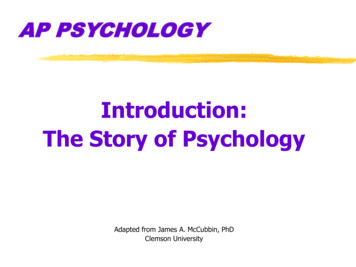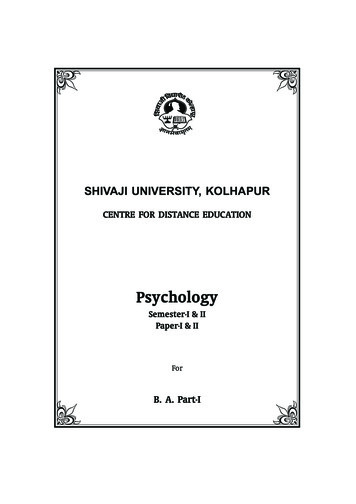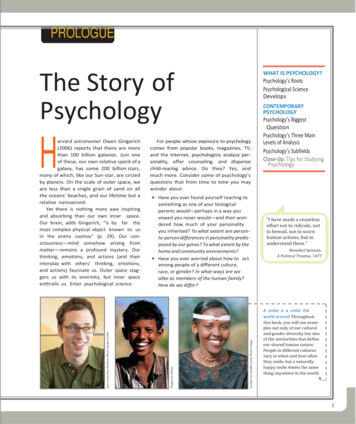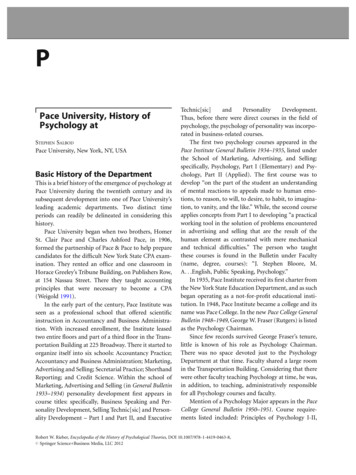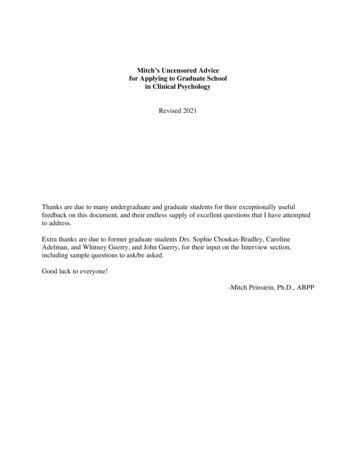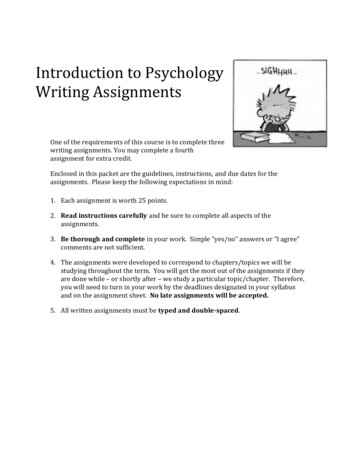
Transcription
Introduction to PsychologyWriting AssignmentsOne of the requirements of this course is to complete threewriting assignments. You may complete a fourthassignment for extra credit.Enclosed in this packet are the guidelines, instructions, and due dates for theassignments. Please keep the following expectations in mind:1. Each assignment is worth 25 points.2. Read instructions carefully and be sure to complete all aspects of theassignments.3. Be thorough and complete in your work. Simple “yes/no” answers or “I agree”comments are not sufficient.4. The assignments were developed to correspond to chapters/topics we will bestudying throughout the term. You will get the most out of the assignments if theyare done while – or shortly after – we study a particular topic/chapter. Therefore,you will need to turn in your work by the deadlines designated in your syllabusand on the assignment sheet. No late assignments will be accepted.5. All written assignments must be typed and double-spaced.
HOW WILL YOUR ASSIGNMENTS BE GRADEDEach of your assignments is worth 25 points and will generally be graded by the following criteria:1.2.3.4.Demonstration of critical thinking, scholarship, and ability to connect and apply the materialComprehensiveness and completeness of your responsesAdherence to the written instructionsSpelling and grammar25 - 23 points – A:Exceptional work -- You have not only met the expectations of the assignment, but your work wouldbe difficult to improve upon. Compared to your classmates, you’ve demonstrated an exceptionalunderstanding of key concepts and the ability to apply them. You have followed all of the instructionsand guidelines; written the ideas in your own words; cited any sources (including your textbook) youmay have used; and have a negligible number of grammar/spelling errors.22 - 20 points – B:Good work – Compared to your classmates, you have demonstrated a good understanding of thematerial and can apply it to your work. You have followed all of the instructions and guidelines;written the ideas in your own words; cited any sources you may have used (including your textbook),and have a minimal number of grammar/spelling errors.19 - 17 points - C:Meets basic expectations – Compared to your classmates, you have demonstrated learning andgeneral understanding of the material, but have missed some opportunities to apply key concepts.Wording is your own, and you have cited any sources that you have used (including your textbook).There may be some formatting and instructional errors, and/or there are several spelling/grammarerrors.16 - 14 points – D:Needs Improvement – Compared to your classmates, you r work is not complete and/or you havemissed several opportunities to demonstrate your understanding of the material and ability to applykey concepts. You neglected to follow two or more instructions or formatting guidelines. Spelling andgrammatical errors are numerous and distracting. There are some errors in providing proper citations.0 points – FYour wording is not your own and you have neglected to provide proper citation and credit for yoursources. You have neglected to answer a number of questions. It appears that you put in very littletime or effort toward this assignment. You failed to turn your assignment in on time.2
Assignment # 1Due by Date: Thursday, March 25 (For Sections 7c)Monday, March 29 (For Section 4b & 4a)THE SENSES CHALLENGEPURPOSE:This assignment corresponds to Chapter 3 of your textbook. The purpose is to give you the opportunityto take the “Senses Challenge” and learn how easily our perceptions can be influenced by illusion andexperience.PROCEDURE:Visit the Senses Challenge ractives/senseschallenge/senses.swf(There is also a link on the Quia page; scroll down about half way down.)1. Take the senses challenge.2. After each question on the challenge, you will be provided with the correct answer. Read theexplanation before moving onto the next question.3. When you have finished taking the challenge, write a short paper (at least one page, typed anddouble-spaced) discussing what surprised you or what you learned. Try to discuss at least onething about each of the five senses. (If you already know everything there is to know about thesenses and are past being surprised, discuss why you think most people are fooled by the opticalor auditory illusions.)4. Be sure to include your name and class section number on the upper left hand of your paper.5. Remember no late homework assignments will be accepted. If you cannot attend class, email youpaper as an attachment or arrange for someone to drop it off at the Student Services Office.Assignment Format:1. A paper at least 1.5 pages long, not including any reference section2. Typed and double spaced, with Arial (10 point font) or Times New Roman (11 or 12 pointfont) and 1 inch margins3. Proofread for spelling and grammatical errors – and indent the first line of each newparagraph.3
Assignment # 2 – OPTION AChoose one of the following four assignment options (A or B), andcomplete your paper by the appropriate due date.Due by Date:Tuesday, April 20 (For Sections 7b)Wed., April 21 (For Section 4a & 4b)USING MNEMONICSMind Tool's (http://www.mindtools.com/memory.html) website on memory techniques and mnemonicswill help you apply the concepts taught in Chapter 5 to improve your own memory. This reviews theunderlying principles of effective mnemonic systems, then introduces several specific mnemonics andapplies them to the remembering of names, dates, telephone numbers, and so on. Of special interest to youwill be the section "Using mnemonics for exams." (You will also find link to this website, Improving YourMemory through Mnemonics, available on the Quia Class Page; scroll about half-way down to find it.)What to Do:Visit the website listed above; read the first article, Memory Techniques (start here), and then choosethree other articles/links to read. Then answer the questions below (assume a short essay format andmeans typed and double spaced). You will be graded on the thoroughness and completeness of yourresponses.1. Identify and describe three specific mnemonic techniques you learned about and explain howeach of these mnemonic devices may be applied to studying for an exam, a speech, lists, or otherinformation. (Be sure to explain this information in your own words.)2. Next, develop and describe a mnemonic to help you remember key concepts/vocabulary for thefollowing essay questions. In order to receive full credit, you must come up with your ownmnemonics for each. (The intention is for you to practice developing your own mnemonics. Youwill only receive credit for creating the mnemonic, not simply answering the question.)a. Identify and describe the two types of LTM information. (Chapter 5)b. Explain both the repressed memory and false memory controversies. What is thedifference between a false memory and a repressed memory? Why may they be confused?(This one might be tricky, but figure out what will be meaningful to you)Assignment Format:1. A paper about 2 pages long, not including any reference section2. Typed and double spaced, with Arial (10 point font) or Times New Roman (11 or 12 pointfont) and 1 inch margins3. Proofread for spelling and grammatical errors – and indent the first line of each paragraph.4. Provide in-text citations and reference any of your sources using APA formatOption B is described on the next page.4
Assignment # 2 – OPTION BDue by Date:Tuesday, April 20 (For Sections 7b)Wed., April 21 (For Section 4a & 4b)MEASURING INTELLIGENCE ON-LINEYou will need to take three intelligence tests to evaluate and compare (You will find web links to them on the Quia Page).STEP ONE: TAKE THE TESTSFirst, visit the www.highiqsociety.org website. Find and click on the “I.Q. Tests.” There are twodifferent types of I.Q. tests available for you to take. Look at the descriptions and explanations ofeach test and then choose one and complete the test according to the directions.Next, visit the www.iqtest.com website, take their test; click on “Let Me Take This Test Now”.(Note, after completing the test, you will be offered to purchase additional tests and certificates –this is not necessary to get your free results! They will be sent to your email address. )Finally, visit the following website and take the Multiple Intelligence test/survey :http://www.bgfl.org/bgfl/custom/resources ftp/client ftp/ks3/ict/multiple int/questions/questions.cfm** After you take these assessments, you may be invited to buy detailed results or become a paid member of some organization.Ignore these! You do not need to purchase anything for this assignment.STEP TWO: RESPOND TO THE FOLLOWING QUESTIONS (Essay-style)1. Briefly identify and describe each of the assessments you took. How did the three scorescompare? (You do not need to share your scores with the instructor.) What might account forthe similarity or difference?2. What variables may have affected your score?3. What evidence do the websites provide about their validity? (You may need to explore thesite before answering this questions.)4. Which test do you think is the more valid measurement of intelligence? Explain why.5. Based on all you have learned about assessing intelligence, summarize the benefits andlimitations of Intelligence Tests. Support your answer with facts and research.ASSIGNMENT FORMAT:1. A paper about 2 pages long, not including any reference section2. Typed and double spaced, with Arial (10 point font) or Times New Roman (11 or 12 pointfont) and 1 inch margins3. Proofread for spelling and grammatical errors4. Provide in-text citations and reference any of your sources using APA format5
Assignment # 3 – OPTION AChoose one of the following four assignment options (A or B), andcomplete your paper by the appropriate due date.Due by Date: Thursday, April 29 (For Sections 7b)Monday, May 5 (For Section 4a & 4b)Identity Crisis in Popular MediaPurpose: This assignment is related to Chapter 9 of your textbook. It is intended to applyidentity theories to current media. Before you begin you will need to read about Marcia’s and Erickson’stheories of adolescent identity.Type/Length of activity: Research and paperPROCEDURES & CONTENTGather Data:Choose a piece of music or literature that expresses as least one of the common themes in adolescentidentity crisis. Some examples would be finding an occupation, deciding on personal values, religiousidentity, or sexual identity.Analyze the Data:1. What audience is targeted by the piece?2. What is the main point(s) or the main plot of the piece?3. How does the piece capture the essence of Erikson’s stage of identity versus role confusion and/orMarcia’s theory of identity status, which includes identity achievement, moratorium, foreclosure, andidentity diffusion?Write Your Report:1. Introduce the topic of adolescent identity crisis.2. Summarize the main points or the plot of the piece.3. Compare the main points or plot to Erikson’s stage of Identity versus Role Confusion and/orMarcia’s identity theory.4. Conclude with a consideration of how such music or literature helps adolescents understandand/or work out their identity crisis.ASSIGNMENT FORMAT:1.A paper about 2 pages long2.Typed, double spaced, with 1 inch margins3.Proofread for spelling and grammatical errors – and indent paragraphs4.Provide in-text citations and reference any sources using APA format6
Due by Date: Thursday, April 29 (For Sections 7b)Monday, May 5 (For Section 4a & 4b)Assignment # – OPTION BThe Effects of Psychoactive DrugsPurpose: This assignment corresponds to information from Chapter 10 of the textbook, and is intended tobetter acquaint students with the effects of psychoactive drugs.PROCEDURE AND CONTENTVisit PSYCHQUEST at chquest/index.htm and select,How Do Psychoactive Drugs Affect Us? (There is also a link on the Quia page; scroll down about two-thirds ofthe way down.)Based on the information learned from the module, answer the following questions “essay-style” in your ownwords.1. What are the four methods by which psychoactive drugs may enter our bloodstream?2. What are the three phases our bodies go through when we are under the influence of psychoactivedrugs?3. Which division of the nervous system is primarily altered by the effects of psychoactive drugs?4. What are the three major classes of psychoactive drugs?5. Briefly describe how amphetamines and cocaine differ in how they work to produce their psychoactiveaffects on our bodies.6. Briefly describe how nicotine and caffeine differ in how they work to produce their psychoactiveaffects on our bodies.7. Briefly explain how morphine and alcohol are similar in how they work to produce their psychoactiveaffects on our bodies.8. Identify and explain the two ways one can develop "tolerance" to psychoactive drugs.9. Which two areas of the brain, and which neurotransmitter are involved in addiction to psychoactivedrugs such as morphine?10. According to research on the mechanisms of drug addiction, what is the most critical factor inaddiction?ASSIGNMENT FORMAT:1. A paper at least 2 pages long, not including any reference section2. Typed and double spaced, with Arial (10 point font) or Times New Roman (11 or 12 point font) and1 inch margins3. Proofread for spelling and grammatical errors4. Provide in-text citations and reference any of your sources using APA format7
Assignment 4 -- OPTION AChoose one of the following four assignment options (A or B),and complete your paper by the appropriate due date.Due by Date:Tuesday, May 18 (For Sections 7b)Wednesday, May 19 (For Section 4b & 4a)PSYCHOLOGICAL DISORDERS & THE MOVIES **PROCEDURE: Watch one of the movies listed below and discuss the main characters and/or plot line interms of psychological disorders and/or treatment. (Some of the movies portray several charactersstruggling with a disorder; you need to focus only on the one or two that most interests you.) Address thefollowing questions:1. What psychological disorder was illustrated in this film? Did the person meet the criteria for“abnormal” in this portrayal?2. What symptoms of mental illness did you see in the movie? After considering typical symptomsand behaviors for this disorder, determine the extent to which you believe this was a realisticportrayal of this disorder.3. Were any causal factors for the character’s disorder suggested in the film? If so, which ones?4. What types of treatment, if any, did the person in the film receive? Provide specific examples.Based on what you’ve learned, is this form typical for individuals with this disorder? Why or whynot?5. What impact did the person’s disorder have on others in his/her life? Do you think the impactwas realistically portrayed? Why or why not?6. After viewing the movie, what do you think it would be like to live with this mental illness?7. What was your overall reaction to the movie and how mental illness was portrayed?Movie Options: (These movies have been previewed and pre-selected for their content and relevance;please do not make your own substitutions without prior approval; failure to do so will result in a zeroscore.)* A Beautiful Mind (Psychosis)* As Good As It Gets (Anxiety Disorder)Benny and Joon (Psychosis)* Clean and Sober (Subst Related Disorder)* The Deer Hunter (Stress Disorder)* The Fisher King (Variety of Disorders)Gia (Substance Related / Mood Disorder)* Girl Interrupted (Variety of Disorders)* Off the Map (Mood Disorder)* One Flew Over the Cuckoo’s Nest (Variety of Disorders)* Ordinary People (Mood Disorder)Rachel at the Wedding (Substance Related Disorders)* Sybil (Stress Disorder)* Three Faces of Eve (Stress Disorder)* Transamerica (Gender Identity Disorder)Twenty-eight Days w/ Sandra Bullock (Substance Related Disorders)* What about Bob? (Anxiety Disorder)What’s Eating Gilbert GrapeIndicates that these titles are available through the Omaha Public Library. Many are also available atvideo rental stores throughout the city. Check online for details.ASSIGNMENT FORMAT:1. A paper at least 2 pages long, not including any reference section2. Typed and double spaced, with Arial (10 point font) or Times New Roman (11 or 12 pointfont) and 1 inch margins3. Proofread for spelling and grammatical errors4. Provide in-text citations and reference any of your sources using APA format8
Due by Date:Assignment 4 -- OPTION BTuesday, May 18 (For Sections 7b)Wednesday, May 19 (For Section 4b & 4a)Attitude & Behavior ChangePURPOSE:This assignment corresponds to Chapter 13 of your textbook. The purpose is to help you identify and apply socialpsychological concepts, especially those associated with attitude and behavior change (and determine which is theeasier to change – hence the title), and techniques used to persuade behavior. Therefore, you should read thechapter before completing this writing assignment, paying particular attention to pages 562-571, and 581-590.PROCEDURE:Imagine that you are a professional change agent and that you have been hired to bring about change in one of thefollowing areas:1.Get people to stop discriminating against a particular minority group (e.g., by hiring more people from thisgroup or by changing their attitude toward it).2.Get people to adopt one or more conservation behaviors (e.g., recycling, wearing seatbelts, volunteerism,reducing gasoline consumption, etc.).3.Get people to vote for a particular candidate who is currently running far behind in the polls.4.Some other problem that interests you.Develop your strategies for changing one of the above behaviors. Use the research and theories described in yourtext to back up your choices of strategies. In a 2 page, double-spaced paper, explain why you are using the variousstrategies. In addition, answer the following questions:1.What problem area have you chosen to work on?2.List the specific goal(s) that you have set in this change program (this is like an operational definition!). Inother words, what actual behavior(s) should show change as a result of your efforts (e.g., increased numberof hours volunteered per week, reduced automobile driving, etc.).3.What techniques would you use to produce the changes listed in question #2; give specific, concreteexamples. For instance, what would the ad look like, what would you say to people as you conducted yourdoor to door campaign, or what incentives or rewards would you give?4.What are the theoretical principles on which your techniques are based? For example, giving everyone anickel if they recycle a plastic or glass bottle is a technique based on reinforcement principles. (RememberChapter 4?!)5.How would you know if your program has been successful? That is, how will you actually assess theamount of change in the behavior(s) that you listed in question #2?ASSIGNMENT FORMAT:1.A paper at least 2 pages long, not including any reference section2.Typed and double spaced, with Arial (10 point font) or Times New Roman (11 or 12 point font) and 1inch margins3.Proofread for spelling and grammatical errors4.Provide in-text citations and reference any of your sources using APA format9
Assignment ChecklistBefore you turn in any written work, be sure you ask yourself the following: When is it due? Is it typed and double-spaced? Did I answer all of the questions? Are my answers complete and thorough? Did I explain answers in my own words and avoid copying text from my textbook orother sources? If I needed to take information directly from another source, did I use quotationmarks and cite my source (including the textbook), by indicating the author,publication date, and page number? When I provide my opinion, belief, or idea about something, did I also explain whyand support my answer? Is my work proofread and free from grammatical errors? Do I understand what I wrote? If someone who did not know much about the topic I’m writing about, understand itbetter after reading my paper? Do I have a backup copy saved?10
will be the section "Using mnemonics for exams." (You will also find link to this website, Improving Your Memory through Mnemonics, available on the Quia Class Page; scroll about half-way down to find it.) What to Do: Visit the website listed above; read the first article,




